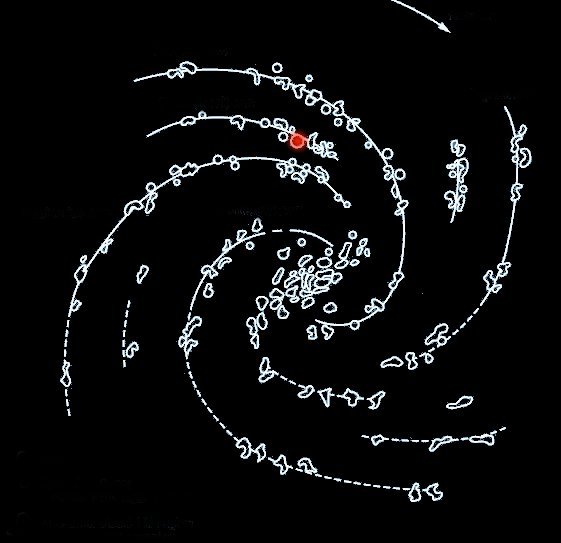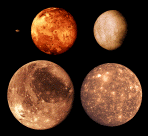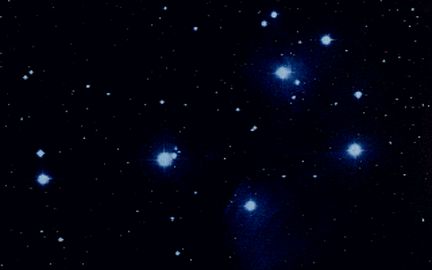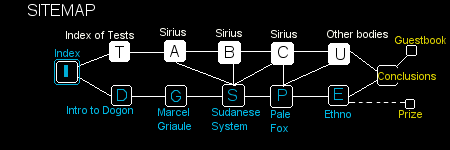
View in detail with labelling and other info *here*. A map for the year 3000.
Test 19
Milky
Way is a rotating spiral
[YES]
Stephen W. Hawking: "A Brief History of Time"
"As long ago as 1750, some astronomers were suggesting that
the appearance of the Milky Way could be explained if most of the
visible stars lie in a single disklike configuration, one example
of what we now call a spiral galaxy. Only a few decades later,
the astronomer, Sir William Herschel, confirmed his idea by
painstakingly cataloging the positions and distances of vast
numbers of stars. Even so, the idea gained complete acceptance
only early this [last] century."
 |
The red spot -- YOU ARE HERE -- is our solar system
in this beautiful plottingof the Milky Way. The arrow to
the top right indicates the direction of rotation. View in detail with labelling and other info *here*. A map for the year 3000. |
Test 20
Saturn
has rings and is
the "star of the Milky Way".
[YES] of course Saturn has rings, but at first glance it is hard
to see the connection with the Milky Way… but wait, if the
galactic plane and spiral arms are the rings, and the Central
Bulge is the planet itself?

Is it that Saturn physically resembles the Milky Way? Decide
for yourself.
Test 21
Jupiter
has 4 moons
[NO] It actually has 16 (4 squared). Although, the relative size
of the 5th moon onwards to the first 4 is shown here:
 |
Top row, l-r: Amalthea, Io, Europa. Bottom row, l-r: Ganymede, Callisto. Io, Europa, Ganymede and Callisto were discovered by Galileo in 1610. Amalthea was discovered by E.E. Barnard in 1892. As we can see, it is a pebble compared to the smallest Galilean satellite, Europa. Also, Amalthea and its other 11 cohorts are trapped asteroids rather than being formed from Jupiter itself like the Galileans. On the face of it, the Jupiter problem is more difficult than Sirius problem: while Sirius has proper motion, no motion of Jupiter suggests its satellites. |
The importance of other planets and stars
The moon is of course, [YES] very
dead.
It is not known whether Venus
having six observable positions corresponds to any meaningful
astronomical fact (any sensible ideas? -- get a prize).
For the other stars, however, it is obvious that persevering with
a literalist interpretation at this point is of not much worth,
as it is clear that the description is of stars as seen rather than
known close up. Most of these stars are binaries; it is tempting
to tie this in with the Dogon idea of twins -- with our solar
system the "unusual" in being a single star to support
life. In fact, some 55% of visible stars are binaries. In a
supreme irony, Procyon, the lesser dog star and a prominent one
mentioned here, is an ABC triplet just like Sirius. The Pleiades
deserve special mention, in relation to being known without a
telescope.
| Pleiades (M45) in Taurus actually has at least 15
members. Nine are mentioned by the Dogon, while Greek folklore calls them the "Seven Sisters" |
 |
Renard Pale presents this enigmatic statement:
'The spiral worlds of stars were populated universes; because, simultaneously with things, Amma, having given form and movement to the world, created all living beings. Just as on our own planet, living beings will live on those other "Earths"...'
(+ Ftnote no. 261)
"This proliferation of life is illustrated by a commentary on the myth, of explanatory value, inwhich it is said: people are on the fourth earth, but on the third there are "people with horns," inneu kelugu, on the fifth, "people with tails," inneu dullogu, on the sixth, "winged people,' inneu gammurugu, on the seventh, "crawling people," inneu bummo, etc. This is to emphasize the absolute ignorance one has of forms of life on other worlds, but also the certainty of the presence of those forms." -- p194
All speculation on the Nommo has been refused, being a case of mythology meeting magic, and disputing ethnographies. However, this passage once again shows the amazing imagination of the Dogon in making descriptions that can be construed as hypothetical exobiologies. To appreciate how rare intelligent life on other planets may be, try these entertaining interactive Drake Equations (1) (2) (3) I found we have to be around for millions of years to give it a chance.
To Conclusions:
